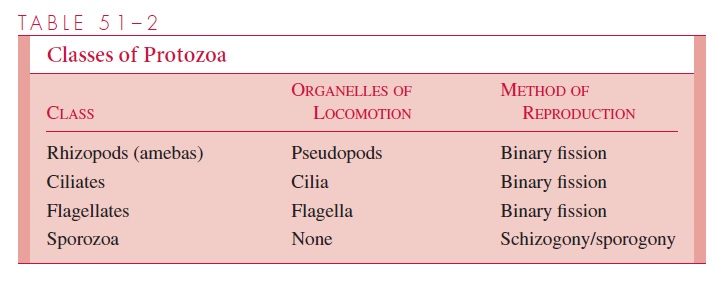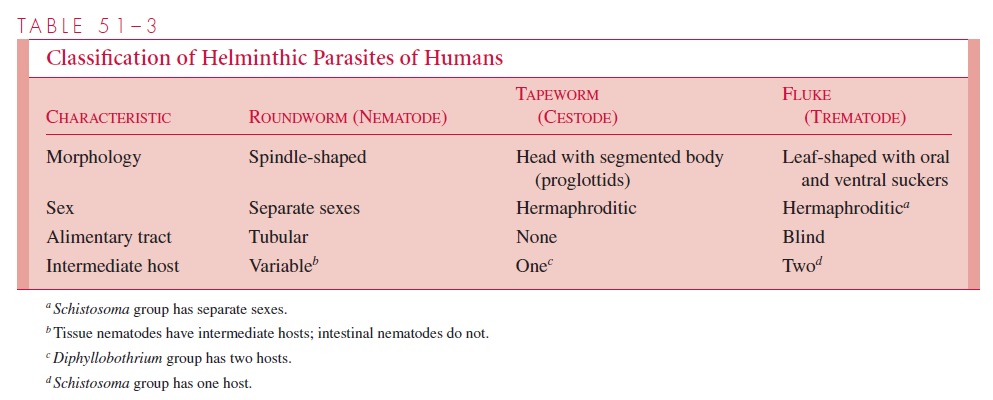Chapter: Medical Microbiology: An Introduction to Infectious Diseases: Introduction to Pathogenic Parasites: Pathogenesis and Chemotherapy of Parasitic Diseases
Biology, Morphology, and Classification
BIOLOGY, MORPHOLOGY, AND CLASSIFICATION
Protozoa
Morphology
Protozoa range in size from 2 to more than 100μm. Their protoplasm consists of a true membrane-bound nucleus and cytoplasm. The former contains clumped or dispersed chromatin and a central nucleolus or karyosome. The shape, size, and distribution of these structures are useful in distinguishing protozoan species from one another.
The cytoplasm is frequently divided into an inner endoplasm and a thin outer ecto-plasm. The granular endoplasm is concerned with nutrition and often contains food re-serves, contractile vacuoles, and undigested particulate matter. The ectoplasm is organized into specialized organelles of locomotion. In some species, these organelles appear as blunt, dynamic extrusions known as pseudopods. In others, highly structured thread-like cilia or flagella arise from intracytoplasmic basal granules. Flagella are longer and less nu-merous than cilia and possess a structure and a mode of action distinct from those seen in prokaryotic organisms.
Classification
Mode of reproduction and type of locomotive organelle are used to divide the protozoa into four major classes (Table 51–2). Although most rhizopods (amebas) are free-living, several are found as commensal inhabitants of the intestinal tract in humans. One of these organisms, E. histolytica, may invade tissue and produce disease. Occasionally, free-living amebas may gain access to the body and initiate illness. The majority of ciliates are free-living and seldom parasitize humans. Flagellates of the genera Trypanosoma and Leishmania are capable of invading the blood and tissues of humans, where they producesevere chronic illness. Others, such as Trichomonas vaginalis and Giardia lamblia, in-habit the urogenital and gastrointestinal tracts and initiate disease characterized by mild to moderate morbidity but no mortality.Sporozoan organisms, in contrast, produce two of the most potentially lethal diseases of humans, malaria and toxoplasmosis.

Physiology
Most parasitic protozoa are facultative anaerobes. They are heterotrophic and must assimi-late organic nutrients. This assimilation is accomplished by engulfing soluble or particulate matter in digestive vacuoles, processes termed pinocytosis and phagocytosis, respectively. In some species, food is ingested at a definite site, the peristome or cytostome. Food may be retained in special intracellular reserves, or vacuoles. Undigested particles and wastes are extruded at the cell surface by mechanisms that are the reverse of those used in ingestion.
Survival is ensured by highly developed protective and reproductive techniques. Many protozoa, when exposed to an unfavorable milieu, become less active metabolically and se-crete a cyst wall capable of protecting the organism from physical and chemical conditions that would otherwise be lethal. In this form, the parasite is better equipped to survive pas-sage from host to host in the external environment. Immunoevasive mechanisms described later (see Immunity) contribute to survival within the host. Reproduction is accomplished primarily by simple binary fission. In one class of protozoa, the Sporozoa, a cycle of multi-ple fission (schizogony) alternates with a period of sexual reproduction (sporogony).
Helminths
Morphology and Classification
Worms are elongated, bilaterally symmetric animals that vary in length from less than a millimeter to a meter or more. The body wall is covered with a tough acellularcuticle, which may be smooth or possess ridges, spines, and tubercles. At the anterior end, there are often suckers, hooks, teeth, or plates used for the purpose of attachment. All helminths have differentiated organs. Primitive nervous and excretory systems and a highly developed reproductive system are characteristic of the entire group. Some have alimentary tracts; none possess a circulatory system. The common helminthic parasites of humans can be placed in one of three classes on the basis of body and alimentary tract configuration, nature of the reproductive system, and need for more than a single host species for the completion of the life cycle (Table 51–3).

Roundworms, or nematodes, have a cylindrical fusiform body and a tubular alimen-tary tract that extends from the mouth at the anterior end to the anus at the posterior end. The sexes are separate, and the male worm is typically smaller than the female. These worms can be divided into those that dwell within the gastrointestinal tract and those that parasitize the blood and tissues of humans. Unlike the latter, those in the gastrointestinal tract generally do not require intermediate hosts.
Tapeworms, or cestodes, have flattened, ribbon-shaped bodies. The anteriorend, or scolex, is armed with suckers and frequently with hooklets, which are used for attachment. Immediately behind the head is a neck that generates a chain of repro-ductive segments, or proglottids. Each segment contains both male and female gonads. The worm lacks a digestive tract and presumably absorbs nutrients across its cuticle. One or sometimes two intermediate hosts are required for completion of the life cycle.
Flukes, or trematodes, are leaf-shaped organisms with blind, branched alimentarytracts. Particulate waste is regurgitated through the mouth. Two suckers, one surrounding the mouth and the second located more distally on the ventral aspect of the body, serve as organs of attachment and locomotion. Most are hermaphroditic and require two interme-diate hosts. The blood-dwelling schistosomes, however, are unisexual and require but a single intermediate.
Physiology
Helminthic parasites are nourished by ingestion or absorption of the body fluids, lysed tissue, or intestinal contents of their hosts. Carbohydrates are rapidly metabolized, and the glycogen concentration of the worms is high. Respiration is primarily anaerobic, although larval offspring frequently require oxygen. A large part of the energy require-ment is devoted to reproductive needs. The daily output of offspring can be as high as 200,000 for some worms. Typically, helminths are oviparous (excrete eggs), but a few species are viviparous (give birth to living young). The egg shells of many parasites with an aquatic intermediate host possess a lidded opening, or operculum,through which the embryo escapes once the egg reaches water. Whether hatched or freeborn, the resulting larva is morphologically distinct from the mature worm and undergoes a series of changes or molts before it achieves adulthood.
Protection from the host’s digestive and body fluids is afforded by the tough cuticle and the secretion of enzymes. Some worms, such as the schistosomes, can protect themselves from immunologic attack by the incorporation of host antigens into their cuticles. The life span of the adult helminth is often measured in weeks or months, but some, such as the hookworms, filaria, and flukes, can survive within their hosts for decades.
Related Topics